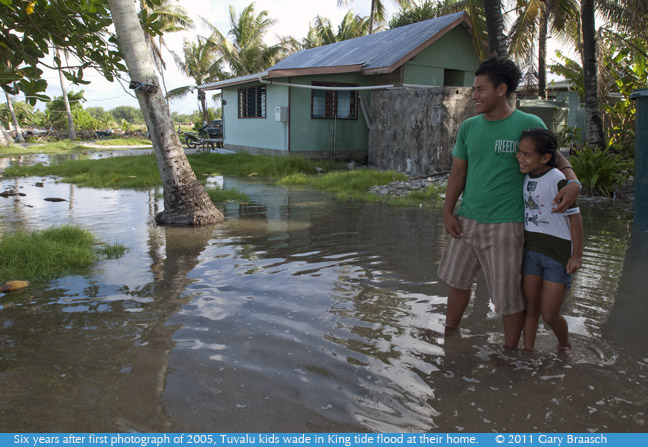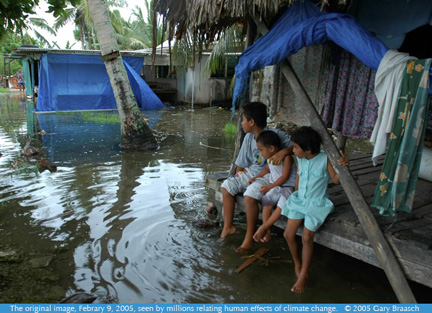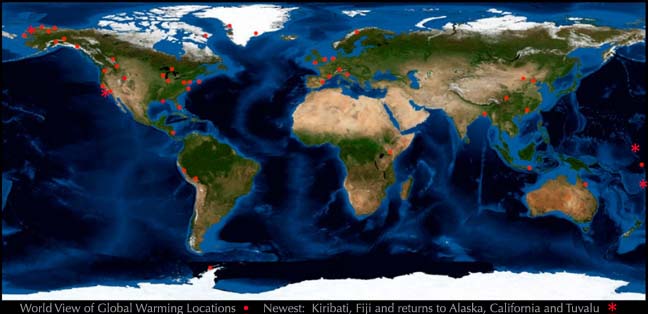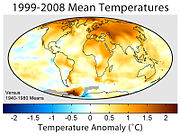Overview
Global mean surface temperature difference from the average for 1880-2009
Mean surface temperature change for the period 1999 to 2008 relative to the average temperatures from 1940 to 1980
Over the last hundred years or so, the instrumental temperature record has shown a trend in climate of increased global mean temperature, i.e., global warming. Other observed changes include Arctic shrinkage, Arctic methane release, releases of terrestrial carbon from permafrost regions and Arctic methane release in coastal sediments, and sea level rise.[4][5] Global average temperature is predicted to increase over this century, with a probable increase in frequency of some extreme weather events, and changes in rainfall patterns. Moving from global to regional scales, there is increased uncertainty over how climate will change. The probability of warming having unforeseen consequences increases with the rate, magnitude, and duration of climate change.[6] Some of the physical impacts of climate change are irreversible at continental and global scales.[7] With medium confidence, IPCC (2007b:17) concluded that with a global average temperature increase of 1–4°C, (relative to 1990–2000) partial deglaciation of the Greenland ice sheet would occur over a period of centuries to millennia.[8] Including the possible contribution of partial deglaciation of the West Antarctic Ice Sheet, sea level would rise by 4–6 m or more.
The impacts of climate change across world population will not be distributed evenly (Smith et al., 2001:957).[9] Some regions and sectors are expected to experience benefits while others will experience costs. With greater levels of warming (greater than 2–3°C by 2100, relative to 1990 temperature levels), it is very likely that benefits will decline and costs increase (IPCC, 2007b:17). Low-latitude and less-developed areas are probably at the greatest risk from climate change (Schneider et al.., 2007:781).[10] With human systems, adaptation potential for climate change impacts is considerable, although the costs of adaptation are largely unknown and potentially large. In a literature assessment, Schneider et al.. (2007:792) concluded, with high confidence, that climate change would likely result in reduced diversity of ecosystems and the extinction of many species.
Definition of climate change
This article refers to reports produced by the IPCC. In their usage, "climate change" refers to a change in the state of the climate that can be identified by changes in the mean and/or variability of its properties, and that persists for extended periods, typically decades or longer (IPCC, 2007d:30).[11] The climate change referred to may be due to natural causes or the result of human activity.
Physical impacts
Main article: Physical impacts of climate change
This section describes some physical impacts of climate change. For some of these physical impacts, their effect on social and economic systems are also described.
Effects on weather
Increasing temperature is likely to lead to increasing precipitation [12][13] but the effects on storms are less clear. Extratropical storms partly depend on the temperature gradient, which is predicted to weaken in the northern hemisphere as the polar region warms more than the rest of the hemisphere.[14]
Extreme weather
See also: Extreme weather, Tropical cyclone#Global warming, and List of Atlantic hurricane records
IPCC (2007a:8) predicted that in the future, over most land areas, the frequency of warm spells or heat waves would very likely increase.[3] Other likely changes are listed below:
- Increased areas will be affected by drought
- There will be increased intense tropical cyclone activity
- There will be increased incidences of extreme high sea level (excluding tsunamis)
Increased freshwater flow
Research based on satellite observations, published in October, 2010, shows an increase in the flow of freshwater into the world's oceans, partly from melting ice and partly from increased precipitation driven by an increase in global ocean evaporation. The increase in global freshwater flow, based on data from 1994 to 2006, was about 18%. Much of the increase is in areas which already experience high rainfall. One effect, as perhaps experienced in the 2010 Pakistan floods, is to overwhelm flood control infrastructure.[15]
Local climate change
Main article: Regional effects of global warming

The first recorded South Atlantic hurricane, "Catarina", which hit Brazil in March 2004
Regional effects of global warming vary in nature. Some are the result of a generalised global change, such as rising temperature, resulting in local effects, such as melting ice. In other cases, a change may be related to a change in a particular ocean current or weather system. In such cases, the regional effect may be disproportionate and will not necessarily follow the global trend.
There are three major ways in which global warming will make changes to regional climate: melting or forming ice, changing the hydrological cycle (of evaporation and precipitation) and changing currents in the oceans and air flows in the atmosphere. The coast can also be considered a region, and will suffer severe impacts from sea level rise.
Biogeochemical cycles
See also: climate change feedback
Climate change may have an effect on the carbon cycle in an interactive "feedback" process . A feedback exists where an initial process triggers changes in a second process that in turn influences the initial process. A positive feedback intensifies the original process, and a negative feedback reduces it (IPCC, 2007d:78).[11] Models suggest that the interaction of the climate system and the carbon cycle is one where the feedback effect is positive (Schneider et al.., 2007:792).[10]
Using the A2 SRES emissions scenario, Schneider et al.. (2007:789) found that this effect led to additional warming by 2100, relative to the 1990-2000 period, of 0.1 to 1.5 °C. This estimate was made with high confidence. The climate projections made in the IPCC Forth Assessment Report of 1.1 to 6.4 °C account for this feedback effect. On the other hand, with medium confidence, Schneider et al.. (2007) commented that additional releases of GHGs were possible from permafrost, peat lands, wetlands, and large stores of marine hydrates at high latitudes.
Glacier retreat and disappearance
Main article: Retreat of glaciers since 1850

A map of the change in thickness of mountain glaciers since 1970. Thinning in orange and red, thickening in blue.
IPCC (2007a:5) found that, on average, mountain glaciers and snow cover had decreased in both the northern and southern hemispheres.[3] This widespread decrease in glaciers and ice caps has contributed to observed sea level rise. With very high or high confidence, IPCC (2007d:11) made a number of predictions relating to future changes in glaciers:[11]
- Mountainous areas in Europe will face glacier retreat
- In Latin America, changes in precipitation patterns and the disappearance of glaciers will significantly affect water availability for human consumption, agriculture, and energy production
- In Polar regions, there will be reductions in glacier extent and the thickness of glaciers.
Oceans
The role of the oceans in global warming is a complex one. The oceans serve as a sink for carbon dioxide, taking up much that would otherwise remain in the atmosphere, but increased levels of CO2 have led to ocean acidification. Furthermore, as the temperature of the oceans increases, they become less able to absorb excess CO2. Global warming is projected to have a number of effects on the oceans. Ongoing effects include rising sea levels due to thermal expansion and melting of glaciers and ice sheets, and warming of the ocean surface, leading to increased temperature stratification. Other possible effects include large-scale changes in ocean circulation.
Acidification
Main article: Ocean acidification
Dissolving CO2 in seawater increases the hydrogen ion (H+) concentration in the ocean, and thus decreases ocean pH. Caldeira and Wickett (2003) placed the rate and magnitude of modern ocean acidification changes in the context of probable historical changes during the last 300 million years.[16] Since the industrial revolution began, it is estimated that surface ocean pH has dropped by slightly more than 0.1 units (on the logarithmic scale of pH; approximately a 30% increase in H+), and it is estimated that it will drop by a further 0.3 to 0.5 units (more than doubling ocean H+ concentrations) by 2100 as the oceans absorb more anthropogenic CO2.[16] [17][18]
Oxygen depletion
The amount of oxygen dissolved in the oceans may decline, with adverse consequences for ocean life.[19][20]
Sea level rise
Main article: Current sea level rise
IPCC (2007a:5) reported that since 1961, global average sea level had risen at an average rate of 1.8 [1.3 to 2.3] mm/yr.[3] Between 1993 and 2003, the rate increased above the previous period to 3.1 [2.4 to 3.8] mm/yr. IPCC (2007a) were uncertain whether the increase in rate from 1993 to 2003 was due to natural variations in sea level over the time period, or whether it reflected an increase in the underlying long-term trend.
IPCC (2007a:13, 14) projected sea level rise to the end of the 21st century using the SRES emission scenarios. Across the six SRES marker scenarios, sea level was projected to rise by 18 to 59 cm (7.1 to 23.2 inches). This projection was for the time period 2090-2099, with the increase in level relative to average sea levels over the 1980-1999 period. Due to a lack of scientific understanding, this sea level rise estimate does not include all of the possible contributions of ice sheets (see the section on abrupt or irreversible changes).
Temperature rise
From 1961 to 2003, the global ocean temperature has risen by 0.10 °C from the surface to a depth of 700 m. There is variability both year-to-year and over longer time scales, with global ocean heat content observations showing high rates of warming for 1991 to 2003, but some cooling from 2003 to 2007.[21] The temperature of the Antarctic Southern Ocean rose by 0.17 °C (0.31 °F) between the 1950s and the 1980s, nearly twice the rate for the world's oceans as a whole.[22] As well as having effects on ecosystems (e.g. by melting sea ice, affecting algae that grow on its underside), warming reduces the ocean's ability to absorb CO2.[citation needed]
Social systems
Main article: Climate change, industry and society
Food supply
Main article: Climate change and agriculture
See also: Food security, Food vs fuel, and 2007–2008 world food price crisis
Climate change will impact agriculture and food production around the world due to: the effects of elevated CO2 in the atmosphere, higher temperatures, altered precipitation and transpiration regimes, increased frequency of extreme events, and modified weed, pest, and pathogen pressure (Easterling et al.., 2007:282).[23] In general, low-latitude areas are at most risk of having decreased crop yields (Schneider et al.., 2007:790).[10] With low to medium confidence, Schneider et al.. (2007:787) concluded that for about a 1 to 3°C global mean temperature increase (by 2100, relative to the 1990-2000 average level) there would be productivity decreases for some cereals in low latitudes, and productivity increases in high latitudes. With medium confidence, global production potential was predicted to:
- increase up to around 3°C,
- very likely decrease above about 3 to 4°C.
Most of the studies on global agriculture assessed by Schneider et al.. (2007:790) had not incorporated a number of critical factors, including changes in extreme events, or the spread of pests and diseases. Studies had also not considered the development of specific practices or technologies to aid adaptation.
Health
Human beings are exposed to climate change through changing weather patterns (temperature, precipitation, sea-level rise and more frequent extreme events) and indirectly through changes in water, air and food quality and changes in ecosystems, agriculture, industry and settlements and the economy (Confalonieri et al.., 2007:393).[24] According to a literature assessment by Confalonieri et al.. (2007:393), the effects of climate change to date have been small, but are projected to progressively increase in all countries and regions.
With high confidence, Confalonieri et al.. (2007:393) concluded that climate change had altered the seasonal distribution of some allergenic pollen species. With medium confidence, they concluded that climate change had:
- altered the distribution of some infectious disease vectors
- increased heatwave-related deaths
With high confidence, IPCC (2007d:48) projected that:[11]
- the health status of millions of people would be affected through, for example, increases in malnutrition; increased deaths, diseases and injury due to extreme weather events; increased burden of diarrhoeal diseases; increased frequency of cardio-respiratory diseases due to high concentrations of ground-level ozone in urban areas related to climate change; and altered spatial distribution of some infectious diseases.
- climate change would bring some benefits in temperate areas, such as fewer deaths from cold exposure, and some mixed effects such as changes in range and transmission potential of malaria in Africa. Overall, IPCC (2007d:48) expected that benefits would be outweighed by negative health effects of rising temperatures, especially in developing countries.
With very high confidence, Confalonieri et al. (2007:393) concluded that economic development was an important component of possible adaptation to climate change. Economic growth on its own, however, was not judged to be sufficient to insulate the world's population from disease and injury due to climate change. The manner in which economic growth occurs was judged to be important, along with how the benefits of growth are distributed in society. Examples of other important factors in determining the health of populations were listed as: education, health care, and public-health infrastructure.
Specific health impacts
| | The neutrality of this section is disputed. Please see the discussion on the talk page. Please do not remove this message until the dispute is resolved. (May 2010) |
Malnutrition
With high confidence, Confalonieri et al. (2007) projected that malnutrition would increase due to climate change.[25] This link is associated with climate variability and change (Confalonieri et al., 2007).[26] Drought reduces variety in diets and reduces overall consumption. This can lead to micronutrient deficiencies.
The World Health Organization (WHO) (referred to by Confalonieri et al., 2007)[27] conducted a regional and global assessment to quantify the amount of premature morbidity and mortality due to a range of factors, including climate change. Projections were made over future climate change impacts. Limited adjustments for adaptation were included in the estimates based on these projections. Projected relative risks attributable to climate change in 2030 varied by health outcome and region. Risks were largely negative, with most of the projected disease burden due to increases in diarrhoeal disease and malnutrition. These increases were primarily in low-income populations already experiencing a large burden of disease.
Extreme events
With high confidence, Confalonieri et al. (2007) projected that climate change would increase the number of people suffering from death, disease and injury from heatwaves, floods, storms, fires and droughts.[25]
Floods and weather disasters
Floods are low-probability, high-impact events that can overwhelm physical infrastructure and human communities (Confalonieri et al., 2007).[28] Major storm and flood disasters have occurred in the last two decades.
The impacts of weather disasters is considerable and unequally distributed. For example, natural disasters have been shown to result in increased domestic violence against - and post-traumatic stress disorders in – women. In terms of deaths and populations affected, floods and tropical cyclones have the greatest impact in South Asia and Latin America. Vulnerability to weather disasters depends on the attributes of the person at risk, including where they live and their age, as well as other social and environmental factors. High-density populations in low-lying coastal regions experience a high health burden from weather disasters.
Heatwaves
Hot days, hot nights and heatwaves have become more frequent (Confalonieri et al., 2007).[29] Heatwaves are associated with marked short-term increases in mortality. For example, in August 2003, a heatwave in Europe resulted in excess mortality in the range of 35,000 total deaths.
Heat-related morbidity and mortality is projected to increase (Confalonieri et al., 2007).[30] The health burden could be relatively small for moderate heatwaves in temperate regions, because deaths occur primarily in susceptible persons.
Drought
The effects of drought on health include deaths, malnutrition, infectious diseases and respiratory diseases (Confalonieri et al., 2007).[26] Countries within the "Meningitis Belt" in semi-arid sub-Saharan Africa experience the highest endemicity and epidemic frequency of meningococcal meningitis in Africa, although other areas in the Rift Valley, the Great Lakes, and southern Africa are also affected (Confalonieri et al., 2007).[31] The spatial distribution, intensity, and seasonality of meningococcal (epidemic) meningitis appear to be strongly linked to climate and environmental factors, particularly drought. The cause of this link is not fully understood.
Fires
In some regions, changes in temperature and precipitation are projected to increase the frequency and severity of fire events (Confalonieri et al., 2007).[32] Forest and bush fires cause burns, damage from smoke inhalation and other injuries.
Infectious disease vectors
With high confidence, Confalonieri et al. (2007) projected that climate change would continue to change the range of some infectious disease vectors.[25] Vector-borne diseases (VBD) are infections transmitted by the bite of infected arthropod species, such as mosquitoes, ticks, triatomine bugs, sandflies, and blackflies (Confalonieri et al., 2007).[33] There is some evidence of climate-change-related shifts in the distribution of tick vectors of disease, of some (non-malarial) mosquito vectors in Europe and North America. Climate change has also been implicated in changes in the breeding and migration dates of several bird species. Several species of wild bird can act as carriers of human pathogens as well as of vectors of infectious agents.
Dengue
It is possibled that climate change will increase the number of people at risk of dengue (Confalonieri et al., 2007).[25] Based on the expert judgement of Confalonieri et al. (2007), this projection had about a two-in-ten chance of being correct. Dengue is the world's most important vector-borne viral disease (Confalonieri et al., 2007).[34] Several studies have reported associations between dengue and climate, however, these associations are not entirely consistent.
Malaria
The spatial distribution, intensity of transmission, and seasonalty of malaria is influenced by climate in Sub-saharan Africa (Confalonieri et al., 2007).[35] Rainfall can be a limiting factor for mosquito populations and there is some evidence of reductions in transmission associated with decadal decreases in rainfall. The effects of observed climate change on the geographical distribution of malaria and its transmission intensity in highland regions remains controversial. There is no clear evidence that malaria has been affected by climate change in South America or in continental regions of the Russian Federation. There is still much uncertainty about the potential impact of climate change on malaria at local and global scales.
| | An editor has expressed a concern that this paragraph lends undue weight to certain ideas, incidents, controversies or matters relative to the article subject as a whole. Please help to create a more balanced presentation. Discuss and resolve this issue before removing this message. (May 2010) |
A paper by researchers from the University of Oxford and the University of Florida published in Nature in May 2010 concluded that claims that a warming climate has led to more widespread disease and death due to malaria are largely at odds with the evidence, and that "predictions of an intensification of malaria in a warmer world, based on extrapolated empirical relationships or biological mechanisms, must be set against a context of a century of warming that has seen marked global declines in the disease and a substantial weakening of the global correlation between malaria endemicity and climate."[36][37]
Other infectious diseases
There is good evidence that diseases transmitted by rodents sometimes increase during heavy rainfall and flooding because of altered patterns of human-pathogen-rodent contact (Confalonieri et al., 2007).[38]
Projections
With very high confidence, Confalonieri et al. (2007) concluded that climate change would have mixed effects on malaria.[25] Malaria is a complex disease to model and all of the published models assessed by Confalonieri et al. (2007) had limited parameterization of some key factors.[39] Parametrization is used in climate models because the resolution of models is insufficient to resolve some physical processes (Randall et al., 2007).[40] Given this limitation, models assessed by Confalonieri et al. (2007) projected that, particularly in Africa, climate change would be associated with geographical expansions of the areas suitable for Plasmodium falciparum malaria in some regions, and contractions in other regions. Projections also suggested that some regions would experience a longer season of transmission. Projections suggested expansions in vector species that carry dengue for parts of Australia and New Zealand.
Diarrhoeal diseases
With medium confidence, Confalonieri et al. (2007) concluded that climate change would increase the burden of diarrhoeal diseases.[25] Childhood mortality due to diarrhoea in low-income countries, especially in Sub-Saharan Africa, remains high (Confalonieri et al., 2007).[41] This is despite improvements in care. Several studies have shown that transmission of enteric pathogens is higher during the rainy season. Some studies have found that higher temperature was strongly associated with increased episodes of diarrhoeal disease in adults and children in Peru. The WHO study, referred to earlier, projected that climate change would increase the burden of diarrhoeal diseases in low-income regions by approximately 2 to 5% in 2020 (Confalonieri et al., 2007).[27]
Ground-level ozone
With high confidence, Confalonieri et al. (2007) projected that climate change would increase cardio-respiratory morbidity and mortality associated with ground-level ozone.[25] Ground-level ozone is both naturally occurring and is the primary constituent of urban smog (Confalonieri et al., 2007).[42] Ozone in smog is formed through chemical reactions involving nitrogen oxides and other compounds. The reaction is a photochemical reaction, meaning that it involves electromagnetic radiation, and occurs in the presence of bright sunshine and high temperatures. Exposure to elevated concentrations of ozone is associated with increased hospital admissions for pneumonia, chronic obstructive pulmonary disease, asthma, allergic rhinitis and other respiratory diseases, and with premature mortality.
Background levels of ground-level ozone have risen since pre-industrial times because of increasing emissions of methane, carbon monoxide and nitrogen oxides (Confalonieri et al., 2007).[43] This trend is expected to continue into the mid-21st century.
Cold-waves
It is expected thatb climate change will bring some health benefits (Confalonieri et al., 2007).[25] It is expected that these benefits will be outweighed by negative climate change effects.
Cold-waves continue to be a problem in northern latitudes, where very low temperatures can be reached in a few hours and extend over long periods (Confalonieri et al., 2007).[44] Reductions in cold-deaths due to climate change are projected to be greater than increases in heat-related deaths in the UK (Confalonieri et al., 2007).[30]
Water resources
See also: Water crisis
In a literature assessment, Kundzewicz et al.. (2007:175) concluded, with high confidence, that:[45]
- the negative impacts of climate change on freshwater systems outweigh the benefits. All of the regions assessed in the IPCC Fourth Assessment Report (Africa, Asia, Australia and New Zealand, Europe, Latin America, North America, Polar regions (Arctic and Antarctic), and small islands) showed an overall net negative impact of climate change on water resources and freshwater ecosystems.
- Semi-arid and arid areas are particularly exposed to the impacts of climate change on freshwater. With very high confidence, it was judged that many of these areas, e.g., the Mediterranean basin, western USA, southern Africa, and north-eastern Brazil, would suffer a decrease in water resources due to climate change.
Migration and conflict
An argument can be made that rising ethnic conflicts may be linked to competition over natural resources that are increasingly scarce as a result of climate change (Wilbanks et al.., 2007:365).[46] According to a literature assessment by Wilbanks et al.. (2007:365), other factors need to be taken into account. It was suggested that major environmentally influenced conflicts in Africa have more to do with the relative abundance of resources, e.g., oil and diamonds, than with resource scarcity. On this basis, Wilbanks et al.. (2007:365) suggested that predictions of future conflicts due climate change should be viewed with caution.
With high confidence, Schneider et al.. (2007:787) predicted that stresses such as increased drought, water shortages, and riverine and coastal flooding would affect many local and regional populations.[10] With medium confidence, it was predicted that these stresses would lead, in some cases, to relocation within or between countries. This might have the effect of exacerbating conflicts, and possibly impose migration pressures.
Zhang et al also concluded that climate change drives conflict.[47]
Aggregate impacts
Main article: Economics of global warming
Aggregating impacts adds up the total impact of climate change across sectors and/or regions (IPCC, 2007d:76).[11] The impacts of climate change across world population will not be distributed evenly (Smith et al., 2001:957).[9] IPCC (2007b:17) found that for increases in global mean temperature of less than 1-3 °C above 1990 levels, some impacts were projected to produce benefits in some places and sectors, and produce costs in other places and sectors.[8] For some low-latitude and polar regions, net costs were projected for small increases in temperature. According to IPCC (2007b:17), a temperature increase of greater than about 2-3 °C would very likely result in all regions either experiencing reductions in net benefits or increases in net costs.
Regions
Some regions are likely to be especially affected by climate change (IPCC, 2007d:9):[11]
- The Arctic, because of high rates of projected warming.
- Africa, especially in the sub-Saharan region. This is due to the continent's low capacity to adapt to climate change and projected impacts.
- Small islands, due to high exposure of population and infrastructure at risk to sea-level rise and increased storm surge.
- Asian megadeltas, due to large populations and high exposure to sea-level rise, storm surge and river flooding.
Within other areas, some people are particularly at risk, such as the poor, young children and the elderly.
Biological systems
Main article: Climate change and ecosystems
See also: Extinction risk from global warming, Effect of climate change on plant biodiversity, and Effects of climate change on marine mammals
With very high confidence, Schneider et al.. (2007:792) concluded that regional temperature trends were already affecting species and ecosystems around the world.[10] In a literature assessment, Rosenzweig et al.. (2007:81) concluded that over the last three decades, human-induced warming had likely had a discernable influence on many physical and biological systems.[48]
Schneider et al.. (2007:792) concluded, with high confidence, that climate change would result in the extinction of many species and a reduction in the diversity of ecosystems.
- Terrestrial ecosystems and biodiversity: With a warming of 3°C, relative to 1990 levels, it is likely that global terrestrial vegetation would become a net source of carbon (Schneider et al.., 2007:792). With high confidence, Schneider et al.. (2007:788) concluded that a global mean temperature increase of around 4°C (above the 1990-2000 level) by 2100 would lead to major extinctions around the globe.
- Marine ecosystems and biodiversity: With very high confidence, Schneider et al.. (2007:792) concluded that a warming of 2°C above 1990 levels would result in mass mortality of coral reefs globally.
- Freshwater ecosystems: Above about a 4°C increase in global mean temperature by 2100 (relative to 1990-2000), Schneider et al.. (2007:789) concluded, with high confidence, that many freshwater species would become extinct.
Abrupt or irreversible changes
Abrupt climate change
Abrupt climate change is defined as a large-scale change in the climate system that takes place over a few decades or less, persists (or is anticipated to persist) for at least a few decades, and causes substantial disruptions in human and natural systems (CCSP, 2008a).[49] There is the possibility of a rapid change in glaciers, ice sheets, and hence sea level. Predictions of such a change are highly uncertain due to a lack of scientific understanding. Modeling of the processes associated with a rapid ice sheet and glacier change could potentially increase future projections of sea level rise.
The Atlantic Meridional Overturning Circulation
See also: Shutdown of thermohaline circulation
The Atlantic Meridional Overturning Circulation (AMOC) is an important component of the Earth's climate system, characterized by a northward flow of warm, salty water in the upper layers of the Atlantic and a southward flow of colder water in the deep Atlantic (CCSP, 2008b, p. 5).[50] Potential impacts associated with MOC changes include reduced warming or (in the case of abrupt change) absolute cooling of northern high-latitude areas near Greenland and north-western Europe, an increased warming of Southern Hemisphere high-latitudes, tropical drying, as well as changes to marine ecosystems, terrestrial vegetation, oceanic CO2 uptake, oceanic oxygen concentrations, and shifts in fisheries (Schneider et al., 2007).[51] According to a assessment by the US Climate Change Science Program (CCSP, 2008b, p. 5), it is very likely that the strength of the AMOC will decrease over the course of the 21st century. Warming is still expected to occur over most of the European region downstream of the North Atlantic Current in response to increasing greenhouse gases, as well as over North America. Although it is very unlikely that the AMOC will collapse in the 21st century, the potential consequences of such a collapse could be severe.
Irreversibilities
An irreversible change is one where that change, once set in motion, cannot be reversed, at least over some specified timescale, e.g., centuries to millennia (Goldemberg et al., 1996, p. 22).[52] Climate change is likely to lead to some irreversible impacts (IPCC, 2007d).[53] One example of a potentially irreversible impact of climate change is damage to ecosystems.
The IPCC report that is referred to in this article uses specific and quantitative language to describe uncertainty (Ahmad et al., 2001).[54] This language is intended to provide an indication of the level of confidence that IPCC authors have about a particular finding. The qualitative language used to describe uncertainty has a quantitative scale associated with it. The quantitative values for qualitative terms are intended to ensure that confidence levels are interpreted correctly. The is because qualitative statements, e.g., using the word "likely," can be interpreted differently in quantitative terms (Moss and Schneider, 2000, p. 44).[55]
Quantitative values for confidence statements made in the IPCC Fourth Assessment Report are listed below (IPCC, 2007).[56] These quantitative values are subjective probabilities (see Ahmad et al., 2001, section 2.6.2) that reflect the expert judgement of IPCC authors:
- a Very high confidence: At least 9 out of 10 chance of being correct
- b High confidence: About 8 out of 10 chance
- c Medium confidence: About 5 out of 10 chance
- d Low confidence: About 2 out of 10 chance
- e Very low confidence: Less than a 1 out of 10 chance
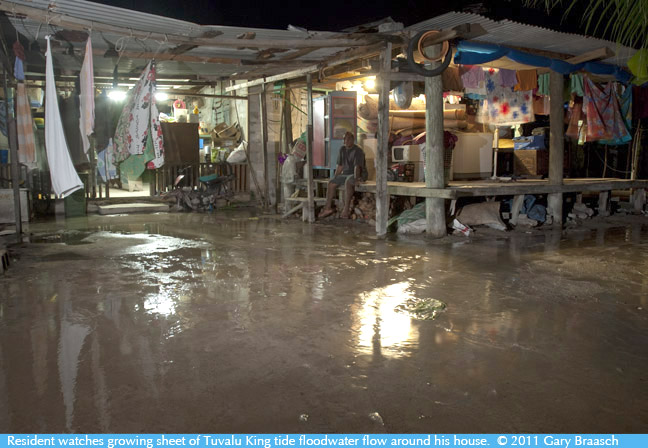 Tuvalu
Tuvalu